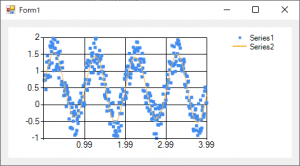Pythonでsgolayフィルタを使ってみた..NETでもオープンソースのコードがないかなと思っていたのですが,なかなか見つからなかったのでscipyのコードを使うことにしてみた.
自分で探していたけど「SciPy で Savitzky-Golay フィルタ」という参考にmodeなるものも指定できることが分かった.SciPyの方が簡単かな
やっぱり簡単.ただし,Scipyはかなりストレージを使う.これを小さくできたらよいのだが...
C#側のコードは次のような感じにしてみた.
using System;
using System.Collections.Generic;
using System.ComponentModel;
using System.Data;
using System.Drawing;
using System.IO;
using System.Linq;
using System.Reflection;
using System.Text;
using System.Threading.Tasks;
using System.Windows.Forms;
using Python.Runtime;
namespace SgolaySample
{
public partial class Form1 : Form
{
public Form1()
{
InitializeComponent();
System.Windows.Forms.DataVisualization.Charting.ChartArea chartArea1 = new System.Windows.Forms.DataVisualization.Charting.ChartArea();
System.Windows.Forms.DataVisualization.Charting.Legend legend1 = new System.Windows.Forms.DataVisualization.Charting.Legend();
System.Windows.Forms.DataVisualization.Charting.Series series1 = new System.Windows.Forms.DataVisualization.Charting.Series();
System.Windows.Forms.DataVisualization.Charting.Series series2 = new System.Windows.Forms.DataVisualization.Charting.Series();
this.chart1 = new System.Windows.Forms.DataVisualization.Charting.Chart();
//
// chart1
//
chartArea1.Name = "ChartArea1";
this.chart1.ChartAreas.Add(chartArea1);
legend1.Name = "Legend1";
this.chart1.Legends.Add(legend1);
this.chart1.Location = new System.Drawing.Point(12, 12);
this.chart1.Name = "chart1";
series1.ChartArea = "ChartArea1";
series1.ChartType = System.Windows.Forms.DataVisualization.Charting.SeriesChartType.Point;
series1.Legend = "Legend1";
series1.Name = "Series1";
series2.ChartArea = "ChartArea1";
series2.ChartType = System.Windows.Forms.DataVisualization.Charting.SeriesChartType.Line;
series2.Legend = "Legend1";
series2.Name = "Series2";
this.chart1.Series.Add(series1);
this.chart1.Series.Add(series2);
this.chart1.Size = new System.Drawing.Size(446, 206);
this.chart1.TabIndex = 0;
this.chart1.Text = "chart1";
this.Controls.Add(this.chart1);
string strPath = Environment.GetEnvironmentVariable("PATH");
string appDir = Directory.GetParent(Assembly.GetExecutingAssembly().Location).FullName + @"\python";
Environment.SetEnvironmentVariable("PATH", Path.PathSeparator + appDir, EnvironmentVariableTarget.Process);
List<double> x = new List<double>(); // Python listへの変換予定
List<double> y = new List<double>(); // Python listへの変換予定
Random random = new Random(0);
for (int i = 0; i < 400; i++)
{
x.Add(0.01 * i);
y.Add(Math.Sin(2.0 * Math.PI * x[i] / 1.0) + random.NextDouble());
}
using (Py.GIL())
{
dynamic sys = Py.Import("sys");
// sample.pyを置くフォルダをパスに追加
sys.path.append(Directory.GetParent(Assembly.GetExecutingAssembly().Location).FullName);
}
using (Py.GIL())
{
dynamic sample = Py.Import("sample");
dynamic ya = sample.filterA(y); // numpy.arrayで返ってくる予定
for (int i = 0; i < x.Count; i++) {
chart1.Series[0].Points.AddXY(x[i], y[i]);
chart1.Series[1].Points.AddXY(x[i], ((double[])ya)[i]);
}
}
}
}
}
sample.pyの例
import numpy as np from scipy import signal def filterA(y): ya = signal.savgol_filter(y, 101, 5); return ya;
タグ:Python , Windows Forms



